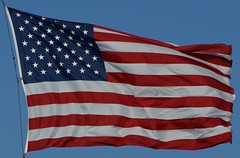
I began this project operating under the assumption that European meat was bound to be better than the American kind, but at least a few fellow expatriates beg to differ. My coworker Chris, who hails from Florida but hasn't been in the States for over a year, gets a starry look in his eyes when he starts talking about American beef. "It's juicy, it smells good...it's just so damn good, I don't know why," he says.
I know why, and it puts a damper on my desire to try U.S. beef: American beef tastes distinctive because it comes from corn-fed animals. At the risk of mentioning Michael Pollan far, far too often (although, if we're to be honest, it's probably already too late), the part of The Omnivore's Dilemma that's stuck with me the most is the fact that cows are not built to digest corn. In fact, eating corn makes cows sick, so cattlemen who feed their animals corn also must pump them full of antibiotics to fight digestive trouble. Corn makes young cows grow quickly, and it gives meat a nice marbled texture, but it's certainly not in the best interest of the cow or the consumer.
I know why, and it puts a damper on my desire to try U.S. beef: American beef tastes distinctive because it comes from corn-fed animals. At the risk of mentioning Michael Pollan far, far too often (although, if we're to be honest, it's probably already too late), the part of The Omnivore's Dilemma that's stuck with me the most is the fact that cows are not built to digest corn. In fact, eating corn makes cows sick, so cattlemen who feed their animals corn also must pump them full of antibiotics to fight digestive trouble. Corn makes young cows grow quickly, and it gives meat a nice marbled texture, but it's certainly not in the best interest of the cow or the consumer.
Still, Americans love their corn-fed beef. A 2002 study showed that consumers are willing to pay 30% more for corn-fed than for grass-fed beef (never mind that corn-fed beef is cheaper to produce, lower in heart-healthy omega-3s, and worse for the environment). My mother tells me that my grandfather, an Oklahoma-raised meat-loving trucker, wanted all his life to try Argentinean grass-fed steak and then was terribly disappointed when he finally did, so attached was he to the flavor of corn-fed beef.
But I can't complain about the taste of the decidedly non-American meat I've eaten. I had a lovely filet de boeuf at critical darling Le Severo earlier this week (and my companion, who just finished a year at culinary school here, proclaimed it the best steak frites he’s had in Paris). I was perfectly satisfied with the meat’s texture: crisp and caramelized on the outside, tender and juicy within. It was tender because filet comes from a part of the body that doesn't get much exercise, not because the cow had gorged on grains. It was also pricey (a well spent 30€), but that's because filet is rare—there's only one psoas muscle per cow. American cattlemen have tried to reproduce the texture and flavor of filet de boeuf in different cuts of meat on the cheap by feeding their cows corn. As a result, Americans have come to see sweet, tender meat as an everyday commodity rather than the luxury that it is.
Lest this post make it sound like I'm knocking an American tradition on the Fourth of July, let me be clear: I love America, and I love eating in America. Far more than stuck-up, self-impressed France, America welcomes and celebrates different food traditions and allows them to develop and intermingle. America also allows for freedom of dietary expression, with more options for vegetarians, vegans, and others who choose to omit certain foods for religious or ethical reasons. What's great about eating in America—much like what's great about living in America—is the diversity and liberty of the experience. I find it hard to believe that a taste of ethically and environmentally questionable corn-fed beef could make me appreciate American alimentary life any more than I already do.
So I wish a very happy birthday to America. But I also hope that, in its 233rd year, the land of the free and the home of the brave might find the bravery to try weaning itself off of corn-fed beef.
1 comment:
Laura, your obviously heartfelt comments on America touched me, and helped me understand some of your feelings about France.
Post a Comment